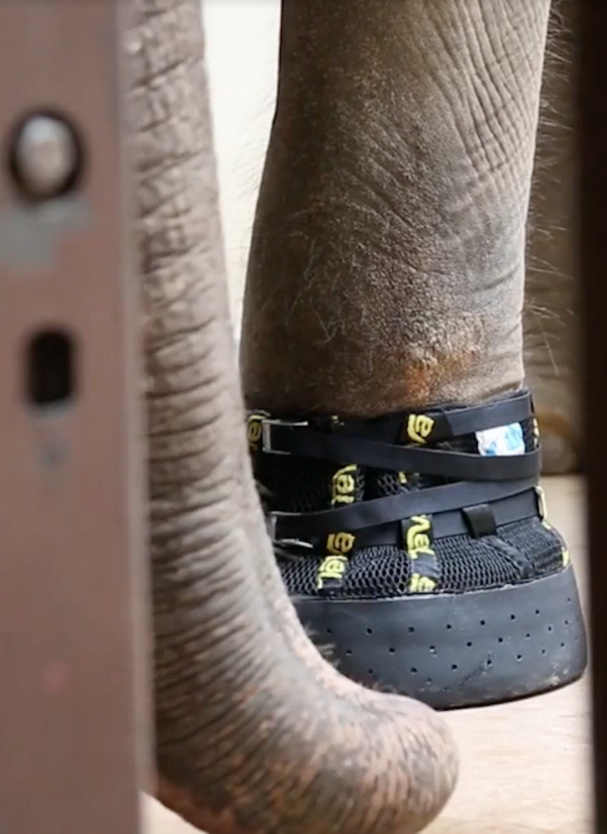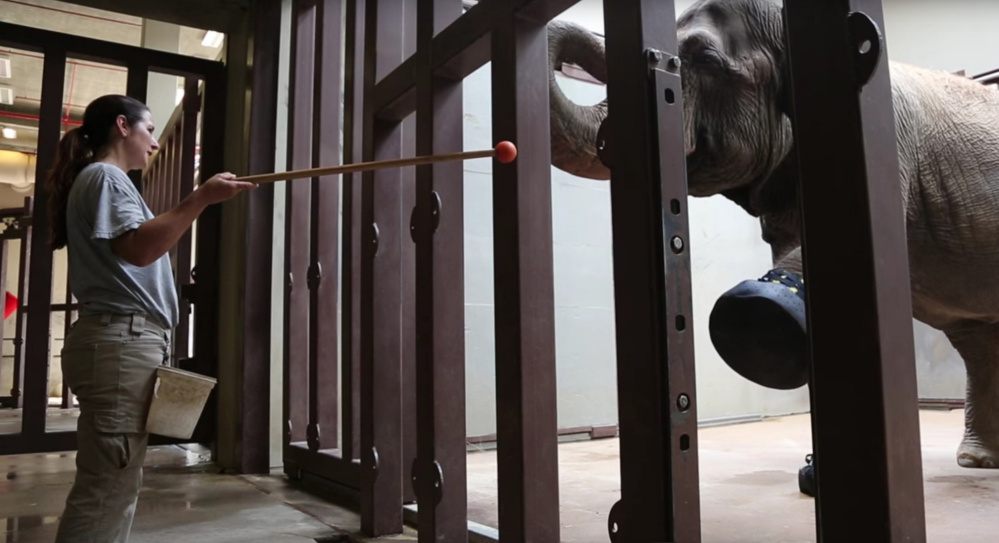WASHINGTON — You think your feet hurt after a long day spent atop them? Imagine weighing 9,000 pounds. That would get your dogs a-barkin’.
That’s the situation that Shanthi, a 41-year-old Asian elephant at the National Zoo, finds herself in. Shanthi suffers from arthritis, which can make getting around painful. It’s also led to problems in her front feet, including cracks in her toenails and lesions on her skin.
The answer: Washington’s largest pair of Teva sandals.
Actually, they’re more like boots, custom made for Shanthi in about a size 20, with an EEEEEEEEEEEE width. Sitting on a table in a staff room in the zoo’s Elephant Community Center recently, a single boot resembled a rubberized birdbath.
When Shanthi wears the boots, said elephant keeper Deborah Flinkman, “She looks like she’s going off-road.”
Elephants have five toenails on their front feet and four (usually) on their back feet. An elephant foot can be close to 20 inches across when it’s resting on the ground, six inches smaller when it’s lifted up and the weight is off it.
“We put a lot of attention into elephant feet,” said Tony Barthel, curator of the zoo’s Elephant Trails and Cheetah Conservation Station exhibits. “It’s one of the things we can do to help ensure that they’re healthy.”
That foot care includes regular inspections, pedicures and occasional X-rays.
Shanthi’s arthritis has caused her to lean forward on her feet, stressing them. Zoo veterinarians needed to treat the arthritis with injections and apply topical treatments to Shanthi’s troubled nails and skin. They also needed to keep debris out of the fissures in her feet.
This all posed a challenge, especially keeping the medication on long enough to work. Elephants are intelligent and curious, with dexterous trunks well-suited for unwrapping bandages. Boots had been used successfully at other zoos, so the National Zoo decided to give them a try.
There is no Brannock device for elephants, that metal contraption humans step in to measure the length and width of their footsies. Instead, the Smithsonian’s 3-D Digitization Program produced scans of her feet that were sent to Teva in California.
The footwear company already had experience with interesting custom jobs. It made a pair of elephant shoes in 2004 and in 2011 created a tiny sandal for the Santa Barbara Zoo, where a Humboldt penguin named Lucky had an impaired foot.
“There’s not a tremendous amount of feedback that comes back from the animals,” said Chris Hillyer, director of innovation for Deckers Brands, which owns Teva. “But the reality is, all the principles we use in making good footwear for humans are absolutely applicable, from the standpoint of traction, durability, drainage and fit.”
Chris flew to China to oversee construction of the shoes, which Teva donated to the zoo gratis.
(A local outfit also made some custom boots for Shanthi before the zoo settled on the Tevas. Joe Stern, of Cobbler’s Bench in Landover, Maryland, fabricated a pair that was hardened with the spray-on lining used for truck beds. Joe finished them off with red soles to make them resemble high-end Christian Louboutin pumps. Shanthi seems to prefer the more casual Tevas.)
What does Shanthi think of wearing shoes?
At first, Tony said, it was like when you “put a sock on a dog and they don’t know how to walk. She did a little bit of that. … She was very careful about how she walked. That was an important part of the learning process.”
Now Shanthi takes the boots in stride.
The arthritis treatment seems to be working. The swelling in her left foot has eased. Keepers have to stuff some foam in the boot to make it fit – elephant orthotics – and Shanthi is more mobile.
Send questions/comments to the editors.




Success. Please wait for the page to reload. If the page does not reload within 5 seconds, please refresh the page.
Enter your email and password to access comments.
Hi, to comment on stories you must . This profile is in addition to your subscription and website login.
Already have a commenting profile? .
Invalid username/password.
Please check your email to confirm and complete your registration.
Only subscribers are eligible to post comments. Please subscribe or login first for digital access. Here’s why.
Use the form below to reset your password. When you've submitted your account email, we will send an email with a reset code.